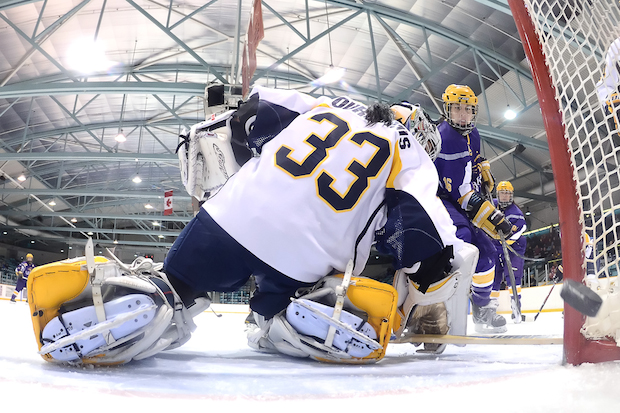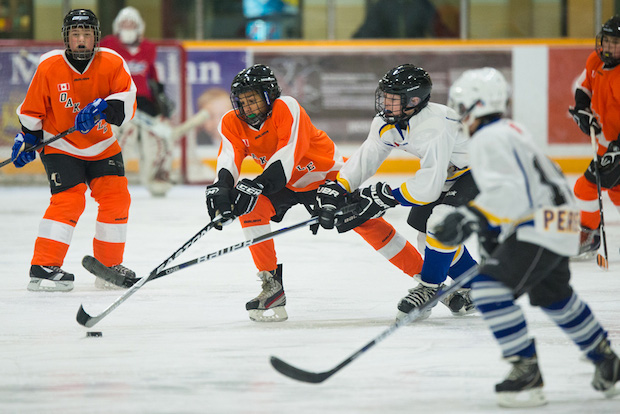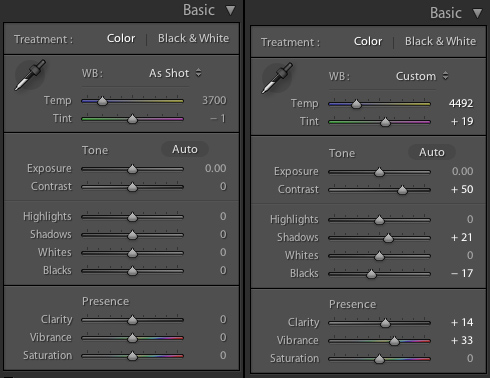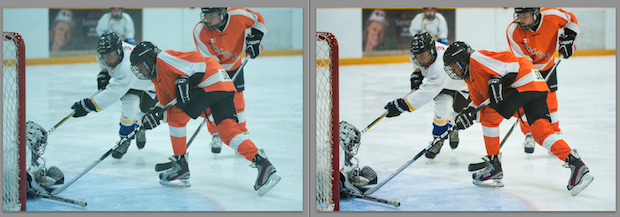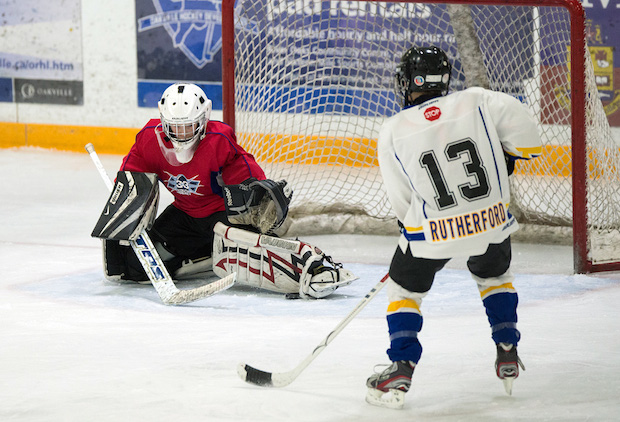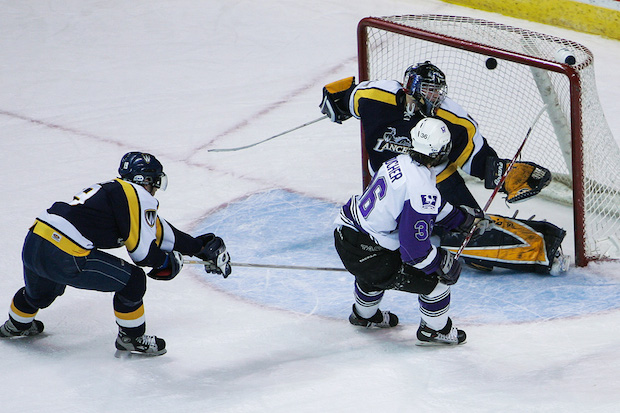This week on Ask the Expert, we figure out what it takes to shoot sports with a zoom.
My question is how to set the white balance when shooting hockey. Should I use cards or use a piece of the ice as my reference?
I have a Sigma 70-200 2.8 lens and still in some dimly lit arena’s it is a challenge to get good photos.
Thanks,
Steve
This weeks answer to Steve’s question comes from Sigma Pro Photographer Kevin Pepper. Here’s Kevin’s response:
Happy New Year Steve,
Great question… I think we first have to look at the three most common forms of lighting used in sporting events to help you understand why this isn’t always as simple as this setting or that setting.
Image courtesy Trevor Mahoney
Three types of lamps are generally used in indoor sports lighting: Tungsten halogen lamps, Fluorescent lamps and High-intensity discharge (HID) lamps. Each type has its advantages and disadvantages for a venue, depending on the type of installation that is required and budget.
Out of the three, high intensity discharge lamps are the ones that are mainly used in hockey rinks. But unfortunately, while great for the venue, they are not so accommodating to photographers.
Image shot with Sigma 120-300mm f/2.8 Sport HSM OS
These lights are then broken down into the following three categories:
• Mercury vapor lamps-the oldest types of high-intensity discharge lighting-are used primarily for street lighting. Mercury vapor lamps provide about 50 lumens per watt. They cast a very cool blue/green white light. Most indoor mercury vapor lamps in arenas and gymnasiums have been replaced by metal halide lamps. Metal halide lamps have better color rendering and a higher efficacy. However, like high-pressure sodium lamps, mercury vapor lamps have longer lifetimes (16,000-24,000 hours) than metal halide lamps.
• Metal Halide Lamps produce a bright, white light with the best color rendition among high-intensity lighting types. They are used to light large indoor areas, such as gymnasiums and sports arenas, and outdoor areas, such as car lots. People who have used the fully licensed paypal sites to place a bet want to be able to see what they have paid for, after all, and whilst this is great for those who want to gamble it can make getting a shot a big more awkward.
• High-Pressure Sodium Lamps are a type of high-intensity discharge lighting and is becoming the most common type of outdoor lighting. High-pressure sodium lamps have an lumens per watt-an efficiency exceeded only by low-pressure sodium lamps. They produce a warm white light.
The first thing to look at to get better photos in the venue to accommodate for this lighting is changing your White Balance. Adjusting your white balance will help with the strange colors you get when shooting under artificial lights without a flash. We’d suggest white balancing on a white or grey card to get closest, or using the guess and check by dialing in your white balance manually to florescent or by Kelvin degrees. Sometimes the ice, while looking white, is actually tinted to one side of the color spectrum and won’t be accurate for the camera.
Image shot with Sigma 120-300mm f/2.8 Sport HSM OS
Why do the colors look all wacky even after white balancing earlier? Well, light comes in all shades of color. True white can be seen under a mid day sun or with a flash. From the standard white, it goes in two directions. Warmer (orange, red, yellow) or colder (blue, green).
Your camera has different tools to help adjust for these shifts. However, most modern indoor venue lights such as the aforementioned, High-intensity discharge (HID) lamps, throw a knuckleball at your camera. They pulse with different intensities of light not effectively captured by the naked eye. It doesn’t do any good to correct one way or the other because they pulse very quickly between tones.
When you are trying to freeze the action, your shutter catches the pulses at different intervals. It is not unusual to get frustrated and end up with one shot that is magenta, one that is green and one that is bluish all in the same burst of 5 to 12 shots…and to add to that, some will be over exposed and some will be too dark.
So, how do the pros deal with this? The top end sports pros are working with flashes mounted in the rafters. So don’t feel bad. Everyone photographing indoors without professional flashes are dealing with the same problem.
While setting your camera to Auto White Balance will not totally correct these color shifts on every frame, it will get you closer to the true colour. You can always tweak it on your computer later if you shoot in RAW by selecting the grey tone in RAW and allowing Bridge or Lightroom make the final adjustments for you.
So that was a really long answer to white balance indoors, but the short answer is that white balancing on cards or the ice won’t have any impact, as the white balance could be changing the whole time you’re shooting. The best bet is to get in auto white balance, or dial in your own white balance (around 3300-4500K) and make the final tweaks in post. You can get close with a quick check of the back of the camera and will need to tweak it in post.
Now let’s address shooting the event and settings. The easy way is to go ahead and put your camera on the auto Sports Mode. The thinking is that the camera will make all the decisions for you and you can just snap away.
The truth is that while sometimes that may work, most of the time your camera meter will be fooled by the inconsistent low light and the dark backgrounds. These factors will throw off your settings and you will end up with blurry photos from slow shutter speeds and grainy photos because the camera threw the ISO too high about half the time.
Here is what I would suggest. You need to take your camera out of Sports Mode, or shutter or aperture priority, and move over to Manual Mode in order to make a few setting adjustments to help you get better photos. While this does require some pre-setting, once you are set up, it never changes for the whole game and you are set for the season. Here are the settings that you need to look at. You will need to know how to adjust these settings while in Manual Mode:
- Aperture (F-stops from 2.8, 3.5, 4, 5.6, 8, 16, 22)
- ISO from (100, 200, 400, 800, 1600, 3200, 6400,12800)
- Shutter Speed from (15, 60, 125, 250, 500, 1000, 2000)
- White Balance (Auto White Balance or AWB)
All of these settings should be easily found on your camera without much work at all and the White Balance setting should already be your default that your camera was set to when you bought it. If you are having a hard time, please look at your camera manual. These settings will be easy to find.
I will not go into all the reasons, that’s a workshop or a much longer answer…. So below I will just give you a starting point. Change your camera to the M or Manual Mode and then raise your ISO number up to 800 or 1600, then drop your Aperture number as low as you can get it. I will use either an F2.8 or 4. Next, raise your shutter speed to 250, then to really freeze the action, set the shutter speed to 500, and finally, move your White Balance to Auto White Balance.
That Sigma 70-200 f2.8 is such a fantastic lens, but if you want some more reach, the new Sigma 120-300 f2.8 is my new workhorse. I have used it at horses races and have been using it consistently shooting birds of prey.
I hope that helps.
Kev
www.northof49photography.com
Ed note: Well that was a big one! Thanks to Kevin for taking the time to provide such great information about indoor venue lighting. Leave a comment with some of your own tips to battle white balance issues for indoor sports below, or on any of the previous Ask the Expert articles, and you’ll be entered to win the Sigma 30mm F1.4 Art lens! Sigma will be drawing a name next Wednesday, January 15th, to take home the lens in the mount of their choice!
Ask the Expert and Win!
Do you have a question you’d like answered on the Blog? Send your questions to expert@gentec-intl.com and if your question is answered on the Blog, you’ll win a BlackRapid RS-4 Camera Strap courtesy of Sigma Canada.
Can you help to expand this answer even further? Leave a comment below with your solution to the question, and you could win a Sigma 30mm F/1.4 Art lens, also courtesy of Sigma Canada. Please make sure to leave a way in your comment for us to get in touch with you if you’re selected as the winner.

